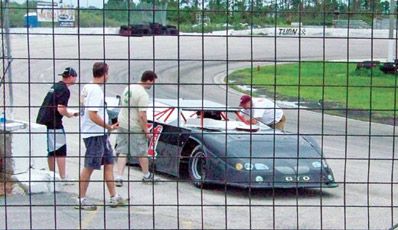
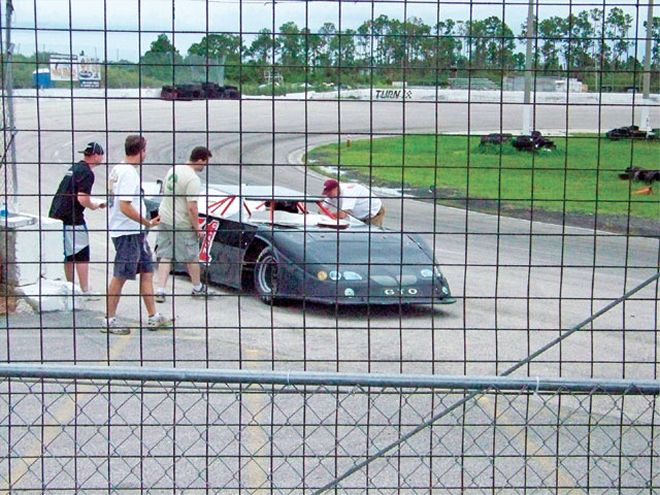 Please do not adjust your set, this is a Dirt Late Model running on asphalt. We reconfigured the car and mounted asphalt tires in preparation for an upcoming series race for Dirt Late Model cars on asphalt. Read how we did it.
Please do not adjust your set, this is a Dirt Late Model running on asphalt. We reconfigured the car and mounted asphalt tires in preparation for an upcoming series race for Dirt Late Model cars on asphalt. Read how we did it.
We have been getting our Dirt Late Model car dialed in at dirt tracks such as North Florida Speedway in Lake City, Florida, and Ocala (FL) Speedway, and we have been getting faster. Then up comes a special promotion by Charlotte County Motorsports Park for a race on its asphalt surface especially for Dirt Late Model cars as a part of the United Dirt Late Model Challenge Series. The race date was August 16th. To say we were excited about the prospects would be an understatement.
Charlotte County is about an hour south of our home base in Tampa, Florida, and is run by and promoted by Bobby Diehl. The sanction for the race is under the UDLMCS banner, and the track offered a test day at Charlotte County on July 8th. This gave us a perfect opportunity to introduce our driver, Bobby Clark, to asphalt racing.
Preparing the car was different, but not so difficult for me. I started out with this whole racing thing on asphalt, and I know these cars well enough to be able to arrange things to work in that environment. The cars were to run on Goodyear asphalt tires that were left over from the Hooters Pro Cup Series when that company supplied their tires. These were very good tires, although they had been in storage for several years. We picked up two sets.
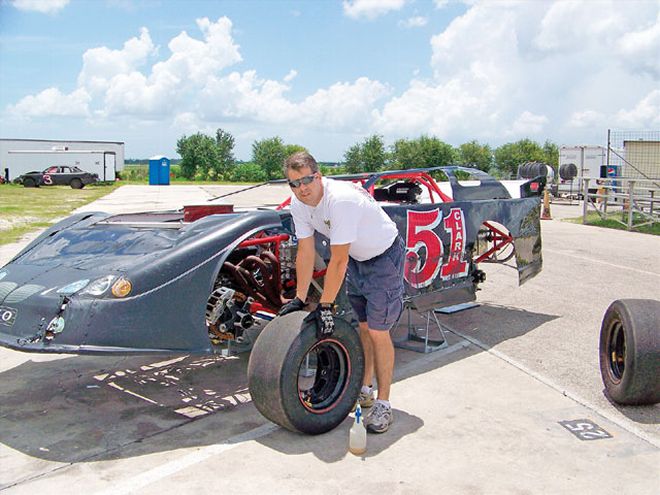 Can you believe it? Editor Rob got busy at the track and actually got his Mechanix Wear gloves dirty. We were hard on him most of the time in good humor, but he really helped out.
Can you believe it? Editor Rob got busy at the track and actually got his Mechanix Wear gloves dirty. We were hard on him most of the time in good humor, but he really helped out.
Our chassis design has the swing arm rear suspension where the coilovers are mounted wide and straight up and onto the trailing arms. This gives us a wide spring base and helps control roll in the rear while presenting a motion ratio for the coilovers that we would have to design around. We had already mostly eliminated the rear steer in this car, and mounted the Panhard bar on the right side of the chassis. So, it was already close to an asphalt car in that respect.
At the shop, Bobby had installed the springs we chose, reset the front cambers to 4 degrees negative on the right front and 3 1/2 degrees of positive at the left front. We toed the front wheels before leaving for the track to 1/8-inch out versus the 1/2-inch out we normally used on dirt.
We did not yet have the tires, so scaling the car was left for after we mounted the asphalt tires due to the difference in stagger between the dirt and asphalt tires. Aero Wheels set us up with two sets of steel, 12-inch wide wheels that we could use. The series recommended that we use wider wheels than the standard 10-inch wheels that are commonly used with these tires.
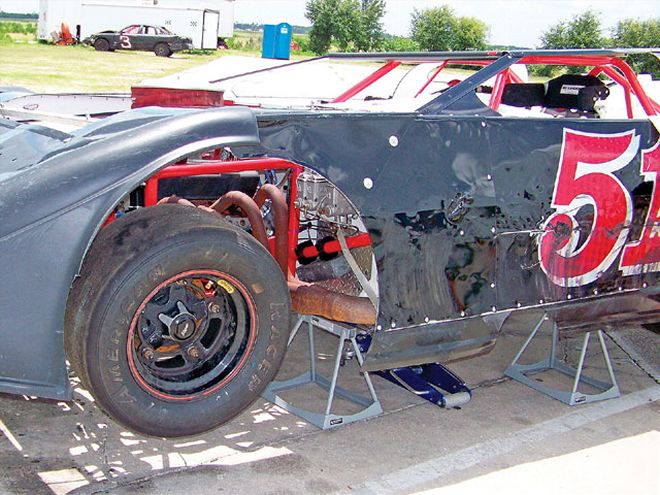 Our first runs were on old American Racer tires that were loaned to us. This gave Bobby a chance to feel out the track without too many expectations. The smaller diameter of these tires vs. our dirt tires looked weird.
Our first runs were on old American Racer tires that were loaned to us. This gave Bobby a chance to feel out the track without too many expectations. The smaller diameter of these tires vs. our dirt tires looked weird.
We needed to move weight around in the car to a more efficient distribution for running the blacktop. So, we ended up moving most of the lead to the front, to the left, and low. This gave us more left side weight (there was no minimum left side weight rule) and a more even front to rear percent, as well as a lower center of gravity. We ended up with 50.4 percent rear, 56 percent left side, and 53.5 percent cross weight by design.
Bobby also reset the Integra shocks to a more standard asphalt setting, putting the compression and rebound for the front shocks at mid-range, and then taking a couple of clicks out of the compression and adding a couple clicks to the rebound side. In the rear we left the left rear at mid-range for compression and reduced the rebound setting a couple of clicks. We increased the right rear compression a couple of clicks and left the rebound there at mid-range.
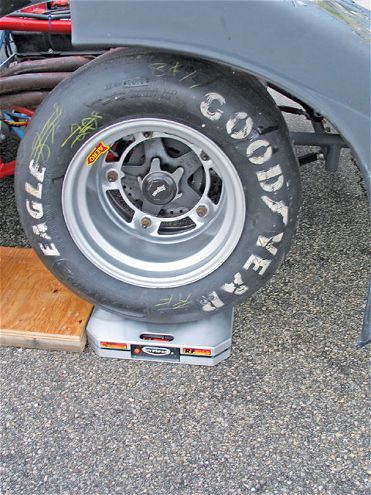 Hey, no wires! We get ready to scale our car at the track with the new Goodyear asphalt tires. Note the new Longacre remote view, wireless scales.
Hey, no wires! We get ready to scale our car at the track with the new Goodyear asphalt tires. Note the new Longacre remote view, wireless scales.
That was all we could do at the shop, so we headed off to the racetrack. Charlotte County is a 1/3-mile low-banked track with wide turns. I could see as we walked the track that the regular racers used the high groove and it would come in handy getting around slower cars. I ran around the track with Bobby in my truck to show him the groove and the lift, braking, and acceleration points. He had never, ever run on asphalt before, so this was going to be quite an experience.
I referred back to an article I had done a few years back with Mike Loescher and Finishline Racing about how to drive on asphalt. I took his three day course at New Smyrna Speedway and learn a bunch. I repeated what Mike had instructed me about the proper line, the lift points, and brake points as we circled the track. Once Bobby took to the track, I would be on the radio moving him around as he practiced. I did notice that my truck was a little tight on entry and loose off.
We mounted the tires, aired them up, and went out for a first session. I told Bobby to take it easy the first time out, and instead of trying to lay down good lap times and use much throttle, try to learn the line and perfect his points. He did great. I was amazed at how quickly he picked this up. We made several initial runs once we had checked all of the systems for leakage and loose bolts.
In the initial runs, the car looked goofy on the track. In setting the corner weights, we had inadvertently jacked the ride heights out of wack. So, we took some time and reset the ride heights and corner weights with our new Longacre wireless remote scales. We were careful to level the scales before taking readings, something we all should do at the track when scaling the car. The car now looked more like it was supposed to.
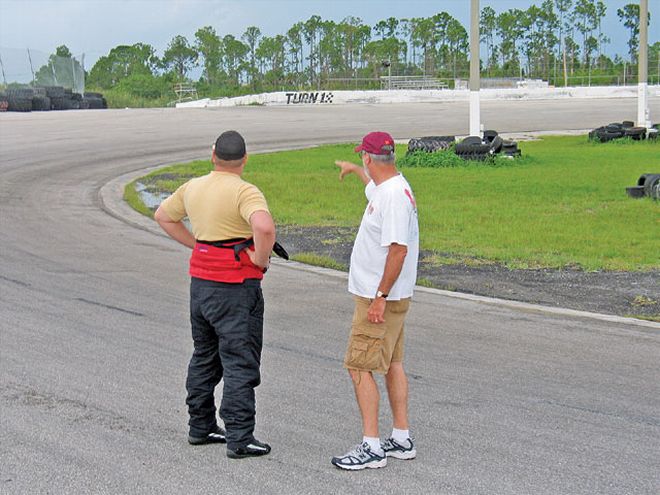 I had a set of radios borrowed from my stint at Daytona with a DP car a week earlier, and Bobby had a RaceCeiver radio installed to hear my instructions. We walked the track before he went out so I could show him the line. Once he got it, his laps were very consistent with both the lap times as well as the line. I was impressed with how quickly he got into the groove.
I had a set of radios borrowed from my stint at Daytona with a DP car a week earlier, and Bobby had a RaceCeiver radio installed to hear my instructions. We walked the track before he went out so I could show him the line. Once he got it, his laps were very consistent with both the lap times as well as the line. I was impressed with how quickly he got into the groove.
During this process Bobby told me that the car would not turn left very well. It wasn't tight and pushing, it was just mechanically hard to turn the steering wheel. We first put the car on stands and checked the mechanics of the steering system. All seemed OK. I then visually inspected the caster settings noting how far rearward the upper ball joints were from the lower ball joints, and concluded that we had more positive caster in the left front than the right front.
This was not by design, but a result of where the ball joints ended up after Bobby rebuilt the left front chassis and strut recently. There was very little of the caster split that is common with asphalt cars to make it mechanically easy for the driver to turn left.
We moved the left lower ball joint rearward by lengthening the forward running strut so that we had approximately 2 degrees of LF caster to go with the 5 degrees of RF caster. This split is common with asphalt cars. The next time out the car turned just like it was supposed to. We made several more runs and I noted Bobby's line and how the car looked.
Bobby was getting more and more comfortable with each run. I made several suggestions about turn entry and driving line, and he responded well to those comments. All the while, the car looked tight to me and so I brought him in to check a few things.
In the process of resetting ride heights we had lowered the rear an inch. When we reset the front caster, we had also inadvertently changed the toe settings. This caused a couple of problems that made the car tight.
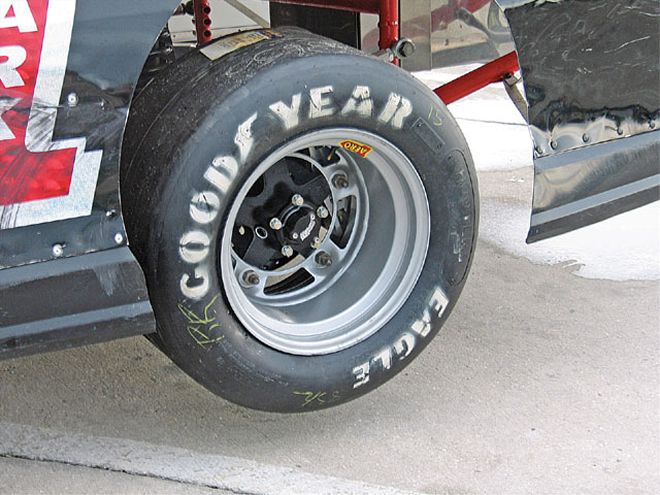 We installed the new Goodyear tires on the 12-inch wide Aero steel rims. At the front, after making adjustments to the caster split to help the car turn left, we found the toe had changed. Once we reset the toe, the car turned much better. Only 1/8-inch of toe-out is needed on asphalt versus a half inch on dirt.
We installed the new Goodyear tires on the 12-inch wide Aero steel rims. At the front, after making adjustments to the caster split to help the car turn left, we found the toe had changed. Once we reset the toe, the car turned much better. Only 1/8-inch of toe-out is needed on asphalt versus a half inch on dirt.
The lowering of the rear lowered the right side of the Panhard bar by one inch, which is a ton. A lower bar resulted in a lower rear moment center and that would increase the rear roll and tighten the car. We did a toe check and found that the car was toed out 5/8-inch, another ton by asphalt standards. So, we retoed the front wheels to 3/16-inch out, raised the right side of the Panhard bar one inch, and went back out.
This time the car looked great. Bobby was getting faster and putting down very consistent lap times. In fact, on the final run of the day under threatening skies, he put down about thirty laps, and the last five were the fastest of the day by far on tires that had close to a hundred laps on them by now.
Along the way we had fine tuned the front cambers after reading the tire temperatures and slightly adjusted the air in the tires, but other than the above, we never touched a spring or shock. We feel that with the way Bobby adjusted to the asphalt driving style and the way the car looked and handled, we should do well come race day. Above are the spring rates we ran with the equivalent rear rates as if the springs were mounted on clamps.
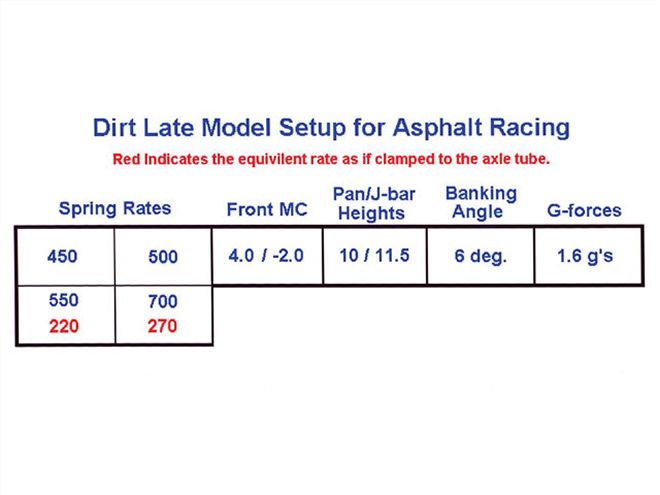 In selecting our spring rates, we needed to balance the roll tendencies front to rear. We did this by using a stiffer right rear spring rate and a Panhard bar height combination. Once we fixed some mechanical problems, the car exhibited the tendencies that relate to a balanced setup, being even front to rear tire temperatures, a good rotation in the middle of the turns and good bite off the corner.
In selecting our spring rates, we needed to balance the roll tendencies front to rear. We did this by using a stiffer right rear spring rate and a Panhard bar height combination. Once we fixed some mechanical problems, the car exhibited the tendencies that relate to a balanced setup, being even front to rear tire temperatures, a good rotation in the middle of the turns and good bite off the corner.
When preparing a dirt car for a run on asphalt, there are several things to make sure you address. The toe setting must be reduced to between 1/8- and 3/16-inch out. Change the caster settings, which are normally more even right to left on a dirt car, to a split with the left being around 2 degrees and the right to between 4 and 5 degrees positive. Eliminate any Ackermann that might be in the steering system.
Move your lead around to achieve a more fifty-fifty front to rear percent. Move it left, too, and down to get more left side weight and a lower CG, all necessary for asphalt racing. Eliminate rear steer in the car. On a four-bar car, drop those upper links and do whatever you need to do in order to decrease the movement of the wheels fore and aft when the chassis rolls.
Run spring rates that will equal out the roll tendencies of the front and rear, i.e. keep the left front tire on the tarmac. Try to relocate the Panhard bar to a right side chassis mount. We had already done this on our car, and it worked out well. Have the driver run a straight line and arc the turns to keep the momentum up. The driver will learn that he can use much more throttle than could be used on most dirt tracks, but don't get carried away. You still must use throttle control on asphalt. If you dirt track the corners, the rear tires will only last a few laps.
Rob Fisher will be at the race with Bobby and crew. I will be far away on Kachemak Bay in Alaska in a float plane, but that is a whole other story. We will document our run and any changes we might need to make. Who knows, more dirt series just might start including asphalt tracks in their schedules much like the ARCA RE/Max Series has the two dirt tracks (DuQuion and Springfield) on its schedule. It make's for a very interesting deviation.